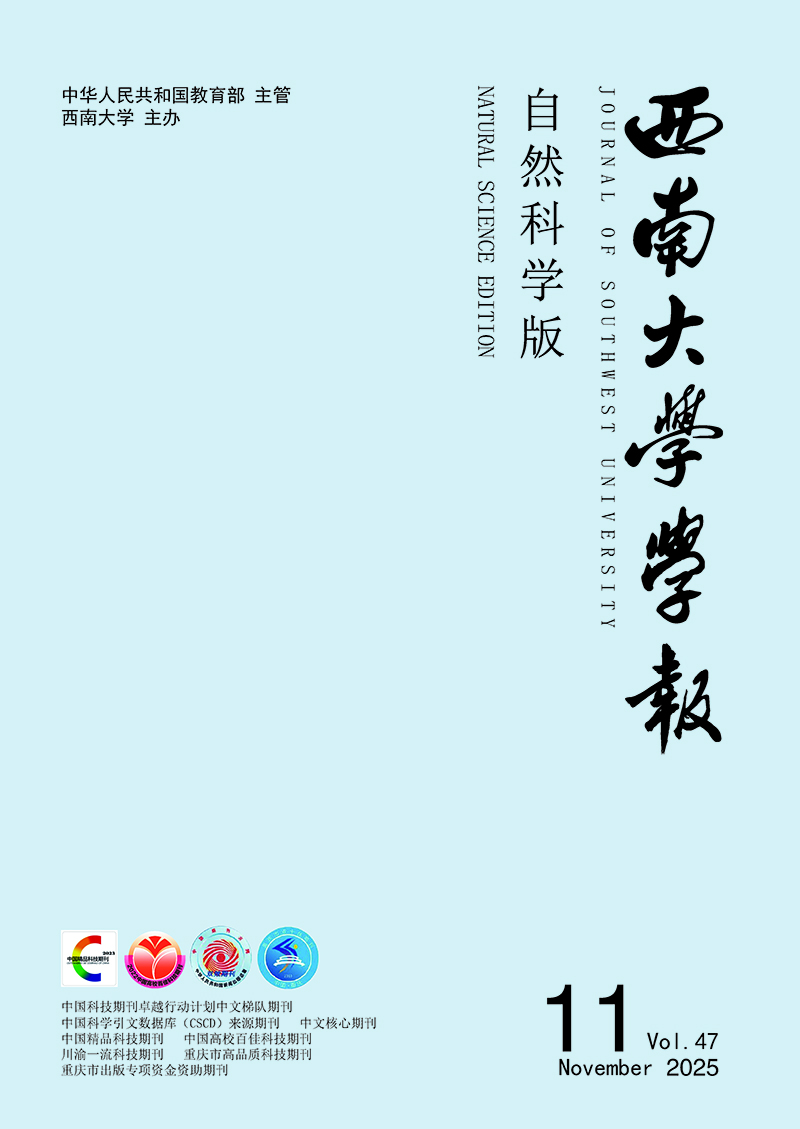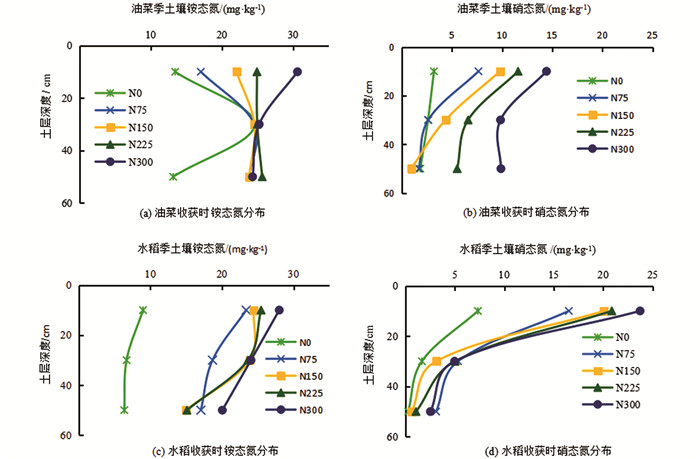-
开放科学(资源服务)标志码(OSID):

-
目前,我国农田氮肥利用率远低于发达国家水平,仅为30%~35%[1]. 大量未被利用的氮肥导致了一系列问题,如土壤肥力不断升高,肥料的增产效应逐渐降低,单位面积氮肥残留量增加等[2-4]. 这已成为我国水环境和大气环境污染的重要原因之一,对我国农业的可持续发展以及人类的生存环境构成了威胁[5-7]. 长江上游是我国重要的农业生态功能区和生态脆弱区,水稻油菜轮作是长江流域最具代表性和分布最广泛的耕作制度之一. 合理施肥是农作物增产的关键环节,然而农业生产中盲目施用化肥的现象非常普遍[8-10]. 最新研究表明,长江流域作物生产总共向水体流入约为6 Tg的氮素,其中油菜约占7.95%,水稻更是达到22.31%,可见,水稻和油菜是水体氮素负荷的主要贡献者之一[11]. 确定重庆地区水稻油菜轮作化学氮肥投入阈值非常必要,以期能达到作物高产、环境友好及农业可持续发展的目的. 朱兆良[12]在总结国内土壤氮素研究结果的基础上,对中国农田中化肥氮的去向进行了初步估计,认为通过氨挥发、表观硝化-反硝化、淋溶、径流等途径损失的氮量约为52%,印证了中国主要粮食产区氮肥利用率低、损失率高的事实. 有研究表明[13-17],合理施用氮肥在水稻、油菜生产中可提高氮肥利用率及偏生产力,也可明显提高土壤肥力、作物产量及经济效益. 因地形、气候、土壤肥力等因素的影响,不同地方油菜和水稻的适宜施氮量不同. 洞庭湖平原油菜施氮量为180 kg/hm2时油菜的产量和氮肥利用效率最佳[18],湖北省油菜适宜施氮量为150 kg/hm2[19],江浙油菜主产区冬油菜的氮肥适宜用量在180~270 kg/hm2之间[20]. 宫亮等[21]确定辽河三角洲地区水稻氮肥施用阈值为210~245 kg/hm2. 施泽升等[22]认为洱海北部地区推荐水稻施氮量为228.26~304.34 kg/hm2. 苏南太湖流域目前生产条件下,兼顾生产、生态和经济比较合理的水稻施肥量为221.5~261.4 kg/hm2[23]. 水稻油菜轮作是水作和旱作交替下进行种植,这种土壤干湿交替变化会引起土壤物理、化学和生物特性的变化,进而对土壤养分循环和土壤肥效产生深刻影响[24]. 目前关于氮肥投入阈值研究多数集中于单季作物水稻或者油菜上,而关于水稻油菜轮作的氮肥投入阈值研究尚未见报道. 本文在重庆永川采用田间随机区组法研究不同氮肥用量对水稻油菜轮作作物产量、氮肥利用、经济效益及氮素平衡的影响,以期为重庆地区水稻油菜轮作氮肥合理施用提供理论依据. 这对实现粮油作物绿色高产高效与农业可持续发展以及保障农业环境安全具有重要意义.
HTML
-
田间试验于2018年10月至2019年8月在重庆市永川区来苏镇水磨滩村三元坝3社(29°16′N,105°48′E)进行. 该区域海拔282 m,年平均气温17.6 ℃,年平均降水量801.1 mm. 供试土壤类型为水稻土,土壤有机质19.3 g/kg,全氮1.70 g/kg,碱解氮184.35 mg/kg,有效磷4.74 mg/kg,速效钾133 mg/kg,pH值5.64,有效硼0.396 mg/kg. 试验期间日均温及日降雨量的动态变化见图 1.
-
供试水稻品种为晶两优534,生育期约为126.8 d;供试油菜品种为宝油早12,生育期约为190 d. 尿素(N,46.4%),过磷酸钙(P2O5,12%),硫酸钾(K2O,52.0%),硼砂(B,11%).
-
试验设置5个氮肥处理(表 1),3次重复,随机区组排列,共15个小区. 每个试验小区面积为20 m2. 油菜季氮肥的基肥、越冬肥和薹肥施用比例为60%,20%和20%. 水稻季氮肥的基肥、分蘖肥和穗肥施用比例为50%,35%和15%. 各个小区磷肥、钾肥和硼肥全部基施,施肥方法均为撒施. 油菜于2018年10月23日直播,播种量为3 kg/hm2,2019年4月25日收获. 水稻于2019年5月29日移栽,密度为15万窝/hm2,每窝2株,移栽株行距为21 cm×30 cm,2019年8月28日收获. 为防止各处理间水、肥串灌和被雨水淋垮,小区间用泥土筑埂并用塑料薄膜包裹隔开. 除施肥外,各小区其他田间管理措施相同.
-
施肥前采集试验地耕层土样并进行理化性质分析. 以整个试验田块为采样单元,采用S形取样方法在试验田块内采集15个土壤样品进行混匀,作为基础土壤样品,风干过筛,供土壤基础理化性质分析用. 土壤有机质采用重铬酸钾容量法测定;全氮采用浓H2SO4消化-流动注射分析仪测定;有效磷采用0.5 mol/L NaHCO3浸提-钼锑抗比色法测定;速效钾采用1 mol/L NH4OAc浸提-火焰光度法测定;pH值按照水土比2.5∶1采用pH计测定[25].
在作物播种前和收获后,每小区采用S形5点法采样,采样深度0~60 cm,每20 cm为1个混合样. 鲜土样约500 g冷藏保存,分析硝态氮、铵态氮、质量含水量(土壤中水分的质量与干土质量的比值). 用烘干法测定新鲜土壤水分质量分数,用KCL浸提法使用吉田流动注射分析仪(德国AutoAnalyzer)测定新鲜土壤样本中的硝态氮和铵态氮质量分数.
-
成熟期各处理采集代表性植株5株,在105 ℃下杀青30 min,而后在75 ℃烘干,植株全氮测定采用浓H2SO4-H2O2消煮-凯氏定氮法.
-
每季作物成熟时每小区随机取样10株考种,并测量生物产量、籽粒产量,各小区单收单打.
-
氮素积累量(N):
氮肥偏生产力(PFPN,以NPFP表示):
氮肥农学利用率(AEN,以NAE表示):
氮肥表观利用率(REN,以NRE表示):
氮肥生理利用率(PEN,以NPE表示):
式中,W为干物质量,ωN为氮质量分数,Y为施氮区作物籽粒产量,F为施氮量,Y0为未施氮区作物籽粒产量,Nx为施氮区植株氮积累量,N0为未施氮区植株氮积累量.
根据氮素平衡模型计算氮的表观损失量. 把化肥施用氮素和土壤矿化氮作为氮素输入来源,不考虑额外的氮素输入,且不考虑氮肥激发效应,假设各处理间土壤氮矿化量相同;氮肥输出仅考虑作物吸收氮素,不考虑挥发和淋溶等因素损失的氮素.
土壤剖面中各土层矿化氮累积量(NMIN):
土壤矿化氮量(∑NMIN):
氮表观损失量(Nal):
式中,d为土层厚度(cm);ρb为土壤容重(g/cm3);C为土壤中矿化氮质量分数(mg/kg);RNMIN为不施氮区土壤残留NMIN;BNMIN为不施氮区土壤起始NMIN.
-
采用EXCEL 2016和SPSS 19.0软件对数据进行处理分析,采用单因素方差分析(p<0.05)的LSD法进行多重比较.
1.1. 试验区概况
1.2. 供试材料
1.3. 试验设计
1.4. 测定项目与测定方法
1.4.1. 土壤样品采集及测定
1.4.2. 植物样品采集及测定
1.4.3. 计产
1.5. 计算公式
1.6. 统计分析
-
由表 2可以看出,施氮处理能显著提高油菜季产量和成熟期氮素积累量(p<0.05),增加幅度分别为73.31%~125.75%和94.86%~187.29%,且N300处理增产效果最佳. 与不施氮处理相比,N300处理使油菜季产量增产1 335.00 kg/hm2,油菜季成熟期氮素积累量增加77.67 kg/hm2. 油菜季氮肥偏生产力、氮肥农学利用率、氮肥表观利用率随施氮量增加均显著下降,由小到大依次为N300,N225,N150,N75. 与低氮处理(N75)相比,中高氮处理(N300,N225,N150)的氮肥偏生产力、氮肥农学利用率和氮肥表观利用率降幅范围分别为40.70%~50.65%,44.52%~67.43%,37.09%~57.13%. 油菜季氮肥生理利用率各个施氮处理之间差异无统计学意义(p<0.05).
水稻季各施氮处理具有显著的增产效果(p<0.05),产量较不施氮处理提高了15.28%~37.74%,其中N225处理效果最佳,增产3 528.57 kg/hm2. 水稻季成熟期氮素积累量增加幅度为25.12%~111.66%,以N300处理效果最佳,增加138.87 kg/hm2. 水稻季氮肥偏生产力和氮肥农学利用率随施氮量增加的变化规律与油菜季相似,较N75处理分别下降了45.57%~71.39%,10.87%~44.78%. 水稻季氮肥表观利用率各个施氮处理之间差异无统计学意义(p<0.05). 水稻季氮肥生理利用率变化动态由小到大依次为N75,N150,N300,N225. 相对于N75处理,其他施氮处理氮肥生理利用率增加幅度为78.29%~146.99%,其中N225处理增幅最大,达到了67.22 kg/kg.
-
油菜收获后耕层0~60 cm土壤剖面中矿质氮质量分数分布见图 2. 由图 2可知,施氮显著提高了油菜季耕层0~20 cm土壤铵态氮和硝态氮的质量分数(p<0.05),而且均有随施氮量增加而增加的趋势. 油菜季耕层20~40 cm土壤中N0,N75和N150处理铵态氮质量分数分别高于耕层0~20 cm,但在耕层20~40 cm各处理之间差异无统计学意义. 这可能是因为施肥和矿化等导致耕层20~40 cm土壤铵态氮质量分数增加且容易被土壤胶体吸附所致. 油菜季耕层40~60 cm各施氮处理土壤铵态氮质量分数也保持较高的水平但处理间差异无统计学意义. 油菜季耕层0~40 cm硝态氮质量分数随土层深度增加而明显减少,同层硝态氮质量分数有随施氮量增加而增加的趋势. 油菜季耕层40~60 cm各处理土壤硝态氮质量分数略低于耕层20~40 cm(N300除外),且N225处理和N300处理土壤硝态氮质量分数显著高于其他处理(p<0.05).
水稻收获后耕层0~60 cm土壤剖面中矿质氮质量分数分布见图 2. 与N0处理相比,施氮显著提高了水稻季耕层0~60 cm土壤铵态氮和硝态氮质量分数(p<0.05),且无机氮质量分数随土层深度增加而减少,耕层0~20 cm土壤无机氮质量分数随施氮量增加而增加. 水稻季耕层20~40 cm的土壤N150,N225,N300处理铵态氮质量分数显著高于N0和N75处理,40~60 cm的土壤N300处理铵态氮质量分数最高且显著高于其他处理(p<0.05).
-
目前常采用一元二次方程或线性加平台方程拟合作物产量和施氮量的关系[2, 13]. 图 3中,在中低施氮量时,产量与施氮量表现为线性正相关(油菜:y=6.533 x+1 157.8,0≤x≤183.38,R2=0.913;水稻:y=16.982 x+9 401.67,0≤x≤193.82,R2=0.913). 在施氮量中等或较高时产量基本保持恒定(油菜:y=2 355.82,x>183.38;水稻:y=12 692.86,x>193.82). 油菜最高产量为2 355.82 kg/hm2,对应施氮量为183.38 kg/hm2,水稻最高产量为12 692.86 kg/hm2,对应施氮量为193.82 kg/hm2. 超过该值,油菜和水稻的籽粒产量增加不再显著,氮肥利用率则下降,肥料对产量的边际收益降低. 总之,该范围对应推荐施氮量既保证了油菜和水稻获得高产又降低了农民的成本投入,减少了氮素的流失.
-
水稻和油菜经济效益是指水稻和油菜收获销售后,除去粮食生产总成本所获得的收益. 根据当地市场销售的肥料价格折纯后N,P2O5,K2O,B价格分别为5.16,5.28,8.00,7.58元/kg,油菜、水稻价格分别按照近3年均价6.00元/kg,2.52元/kg计算. 由图 4可知,油菜和水稻的经济效益随着施氮量增加呈现出先增后减的趋势,油菜的最佳经济施氮量为249.30 kg/hm2,此时农民经济效益为11 907.60元/hm2;水稻的最佳经济施氮量为246.61 kg/hm2,此时农民经济效益为29 706.62元/hm2.
-
施氮量和作物吸氮量、氮素表观损失量关系如图 5. 油菜季施氮量和作物吸氮量呈现线性加平台的关系. 当施氮量x≤218.57 kg/hm2时,油菜吸氮量随施氮量增加而提高,其线性回归方程为y=0.297x+47.564,R2=0.895;当施氮量x>218.57 kg/hm2时,油菜吸氮量随着施氮量增加而保持恒定,其回归方程为y=112.48. 油菜季施氮量和氮素表观损失量呈线性关系,其回归方程为y=0.402 2 x-33.427,R2=0.860. 水稻季吸氮量与施氮量呈现线性加平台的关系. 当施氮量x≤245.32 kg/hm2时,水稻施氮量和吸氮量呈线性相关关系,其线性回归方程为y=0.59 x+119.032,R2=0.879;当施氮量x>245.32 kg/hm2时,水稻吸氮量随着施氮量增加而保持恒定,其回归方程为y=263.77. 水稻季施氮量和氮素表观损失量呈线性关系,其回归方程为y=0.707 9 x-110.06,R2=0.925. 当油菜季和水稻季化学氮肥投入量分别为83.11 kg/hm2和155.47 kg/hm2时,氮素表观损失量为0;当油菜和水稻化学氮肥投入量小于该值时,氮素表观损失量为负值;当油菜季化学氮肥投入量为83.11~218.57 kg/hm2,水稻季化学氮肥投入量为155.47~245.32 kg/hm2时,氮素处于最大作物吸氮量和最小氮素表观损失量之间,既满足了作物的生长,又使氮素损失较少,可作为平衡作物吸氮量和环境友好的合理投入阈值.
2.1. 施氮水平对稻油轮作产量及氮肥利用率的影响
2.2. 施氮水平对稻油轮作土壤剖面无机氮分布的影响
2.3. 油菜水稻轮作作物产量与施氮量的关系
2.4. 油菜水稻轮作作物经济效益与施氮量的关系
2.5. 油菜水稻轮作作物吸氮量、土壤氮素表观损失量和施氮量的关系
-
作物高产与农户增收是合理施肥的重要目的,也是科学施肥技术得以应用的重要保障[29]. 我们在选取不同的肥效效应函数拟合经济阈值和产量阈值时,首先应该考虑到函数的拟合程度和阈值对应氮肥投入量的节省情况[30]. 本试验采用线性加平台函数对作物产量和施氮量进行拟合,以作物最高产量的95%和最高产量为置信区间,有效降低了施氮量,并保证作物高产[31-32]. 结果表明,重庆地区油菜水稻轮作系统中油菜的产量阈值为2 238.03~2 355.82 kg/hm2,对应化学氮肥投入量为165.35~183.38 kg/hm2;水稻的产量阈值为12 058.50~12 692.86 kg/hm2,对应化学氮肥投入量为156.45~193.82 kg/hm2. 本文利用一元二次函数对经济效益和施氮量进行拟合,在不显著降低农户收益的情况下,分别得出油菜季经济阈值为11 312.18~11 907.60元/hm2,对应施氮量为172.41~249.30 kg/hm2;水稻季经济阈值为28 221.34~29 706.62元/hm2,对应施氮量为135.17~246.61 kg/hm2. 由于农民对经济效益最大化的追求往往会导致氮肥的浪费,进而导致环境污染,所以最佳经济施氮量通常可作为氮肥阈值的上限,这与宫亮等[21]的研究方法相同.
氮素是农业生产中作物高产的重要保障,但是一味追求高产而过量施肥会降低氮肥利用率,并产生水体富营养化、氨挥发和硝酸盐污染的环境问题[33-36]. 根据朱兆良[37]对中国大量施肥田间试验的统计显示,在目前生产水平下,施氮量为150~180 kg/hm2时,大田作物已经可以达到较高的产量. 但为满足我国人口增长和生活改善的国情,农民们增加了化学氮肥投入,但过量氮肥投入必然导致氮肥利用率下降和氮素流失所引发的一系列问题. 朱兆良[38]认为,我国农田中当季氮肥利用率仅为30%~35%,高产区更是低于30%. 张福锁等[39]、巨晓棠等[40]认为,我国主要粮食作物的氮肥利用率仅为27.5%,比发达国家低10%~20%. 有研究认为,氮肥施用30年后仍会在土壤中残留12%~15%的氮素,土壤残留氮的后效更是在50年之上[41]. 目前使用差减法得到的氮肥利用率并没有考虑肥料的后效,我们应该从土壤氮库的供氮能力出发,寻找氮素残留和消耗氮库之间的平衡,从而达到作物高产和环境友好的目的. 有研究表明,在农业生产中约有5%~10%的氮素以气态形式挥发,约20%~25%的氮素以径流和渗漏形式损失,剩余大部分以无机氮的形态残留于土壤剖面中[42]. 土壤无机氮质量分数代表了土壤供氮的状况[43],因此,本文根据氮素平衡模型计算氮素的表观损失量,最后综合考虑土壤氮素表观损失量和植株吸氮量,得出重庆地区稻油轮作中油菜季氮肥环境阈值为83.11~218.57 kg/hm2,土壤氮素表观损失量为0~54.48 kg/hm2;水稻季氮肥环境阈值为155.47~245.32 kg/hm2,土壤氮素表观损失量为0~63.60 kg/hm2. 这维持了土壤供氮和植物需氮趋于平衡,土壤供氮能力和产量得以维持,农业生产得以可持续发展. 本文确定的化学氮肥投入阈值可作为区域氮肥施用的参考值,后期可通过进一步试验加以验证和修正.
-
施氮量在0~225 kg/hm2范围内能显著提高重庆地区水稻油菜轮作的作物产量和氮素积累量. 油菜季氮肥偏生产力(PFPN)、氮肥农学利用率(AEN)、氮肥表观利用率(REN)及水稻季PFPN和AEN均随氮肥增加呈现下降趋势,水稻季REN则呈先增加后下降的趋势.
在重庆地区稻油轮作系统中,氮肥用量与油菜和水稻产量(油菜季R2=0.913,水稻季R2=0.913)以及作物吸氮量(油菜季R2=0.895,水稻季R2=0.879)均呈线性加平台关系,与油菜和水稻经济效益(油菜季R2=0.914,水稻季R2=0.898)均呈二次曲线关系,与土壤氮素表观损失量(油菜季R2=0.860,水稻季R2=0.925)均呈线性关系.
综合考虑稻油轮作系统中目标产量、经济效益以及环境因素,重庆地区稻油轮作区油菜季化学氮肥投入阈值应为172.41~183.38 kg/hm2,目标产量为2 284.15~2 355.82 kg/hm2,土壤氮素表观损失量为35.92~40.33 kg/hm2,农民收益为11 312.18~11 469.95元/hm2;水稻季化学氮肥投入阈值为156.45~193.82 kg/hm2,目标产量为12 058.50~12 692.86 kg/hm2,土壤氮素表观损失量为0.69~27.15 kg/hm2,农民收益为28 734.43~29 373.33元/hm2.











 DownLoad:
DownLoad: